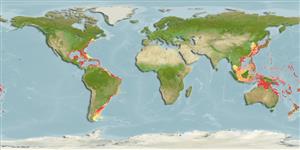Common names from other countries
Classification / Names / Names
Common names | Synonyms | Catalog of Fishes (gen., sp.) | ITIS | CoL | WoRMS
Environment: milieu / climate zone / depth range / distribution range
Ecology
Reef-associated; brackish; depth range 0 - 100 m (Ref. 101942). Subtropical
Western Atlantic and Western Central Pacific.
Length at first maturity / Size / Weight / Age
Maturity: Lm ? range ? - ? cm Max length : 2.0 cm BRW male/unsexed; (Ref. 415)
Ramose to massive-encrusting. Branches: 1 - 2 cm wide. Light grayish, pink or purple, externally, lighter internally. Surface from smooth to extremely spiny, with or without zooanthids. Oscules: 0.2 - 0.7 cm in diameter. Spongy but tough in consistency (Ref. 415).
At Bocas, common both in the reef and in the mangroves (Ref. 415). Commensal with amphipods (Ref. 82302, 86735). Inhabits coralline algae reef, algal nodules, and lower mesophotic reefs (Ref. 128739).
Life cycle and mating behavior
Maturity | Reproduction | Spawning | Eggs | Fecundity | Larvae
Members of the class Demospongiae are hermaphroditic. Life cycle: The zygote develops into parenchymella larva (free-swimming) before settling down on a substrate where it grows into a young sponge.
Collin, R., M.C. Díaz, J. Norenburg, R.M. Rocha, J.A. Sánchez, M. Schulze, A. Schwartz and A. Valdés. 2005. (Ref. 415)
IUCN Red List Status (Ref. 130435)
CITES status (Ref. 108899)
Not Evaluated
Not Evaluated
Human uses
| FishSource |
Tools
Internet sources
Estimates based on models
Preferred temperature
(Ref.
115969): 14.7 - 28.6, mean 26.1 (based on 1344 cells).
Vulnerability
Low vulnerability (10 of 100).
Price category
Unknown.
